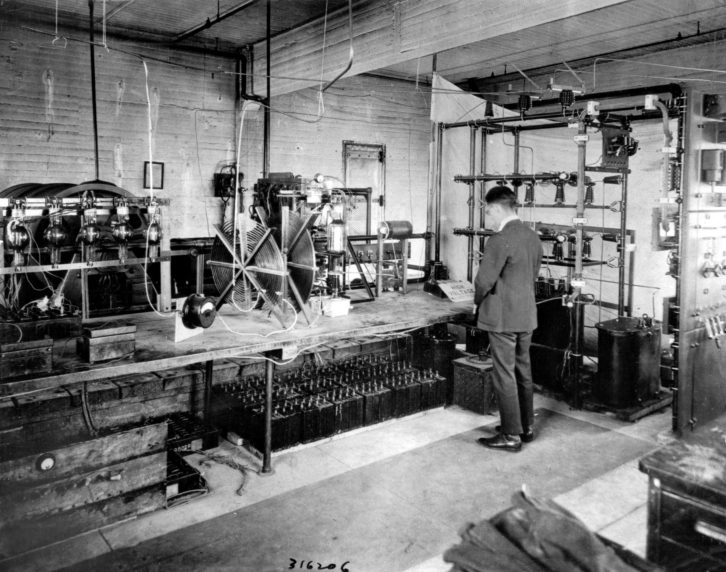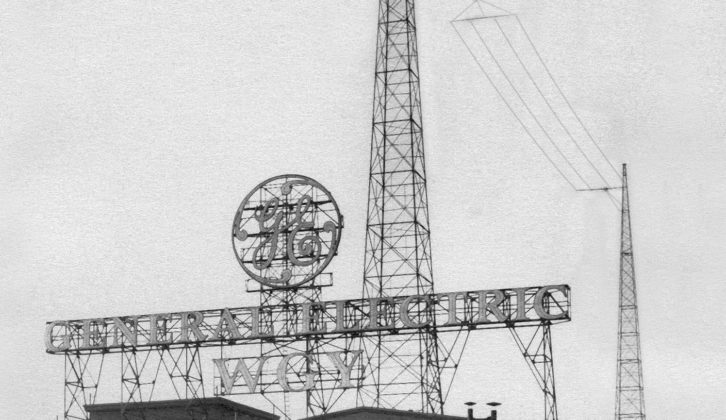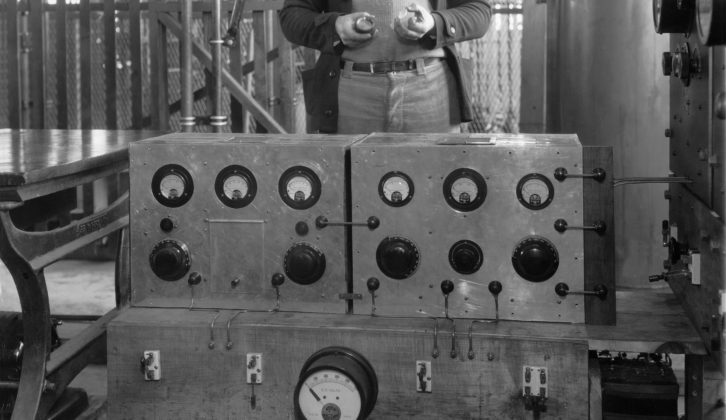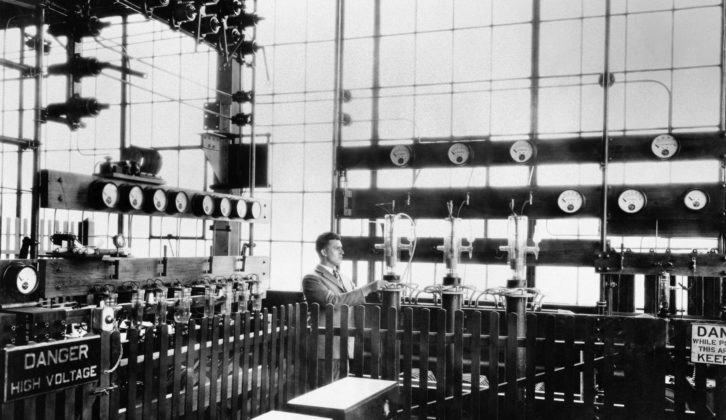WGY in Schenectady, N.Y., celebrated its centennial birthday this year, one of several dozen pioneer broadcasting stations that crossed the 100-year finish line in 2022.
Though all these stations are notable for their endurance and importance to the industry, WGY stands tall for contributing to the science of broadcasting, particularly in its first decade of its operation. For that reason Radio World is ending the year with this special photo essay about the station.
WGY began life as the flagship station of the General Electric Company, operating from G.E.’s massive campus in Schenectady. At that time, G.E. was a veritable cradle of radio technology, and WGY was nursed by some of the world’s most capable engineers and scientists, among them Dr. E.F.W. Alexanderson, Dr. Charles Steinmetz, Irving Langmuir and A.D. Ring.
G.E. invested nearly $10 million in the 1920s for the study of RF propagation, transmitters and power vacuum tubes, and WGY was its field laboratory.

At the dawn of broadcasting, stations used telephone-mouthpiece microphones and wind-up phonographs to feed their programs to crude homebuilt transmitters. Early vacuum tubes were low-powered, unstable, expensive and short-lived.
That had all changed by the end of the decade, when stable, powerful transmitters, elaborate studio equipment and high-fidelity microphones were delivering quality programs to listeners. Most of these technological improvements were developed by just three companies: AT&T, Westinghouse and General Electric.
WGY, blessed with near-unlimited funding by one of the world’s largest corporations, served as the laboratory where much of those technologies were tested.

Going haywire
WGY was birthed on Feb. 20, 1922, the 12th broadcaster in the country. Its two-room studio was on the fourth floor of G.E. Building 36, with a transmitter squeezed into the elevator room of Building 40 a half-mile away. Two 180-foot towers and a flat-top antenna rose from the rooftop.
That first transmitter, capable of 1,500 watts (considered high power for the time) was a “haywire” contraption — open wooden frames supporting coils, wires and vacuum tubes. Dr. W.R.G. Baker, in charge of radio transmitter development, built the transmitter, and William C. White, head of the vacuum tube division, crafted the tubes.
White later said, “It was a crude affair and, as we look at pictures of the equipment at that time, it is a wonder that it ever stayed together.” Even after WGY went on the air, the transmitter was continually being altered as new circuits and tubes were tested.
Click to toggle through photos.
Received across most of the eastern United States at night, WGY quickly drew attention for its quality programming.
Besides a regular schedule of live music, news and farm bulletins, WGY was the first station to experiment with radio drama, producing a new “radio play” each week. But although these programs were well-received by listeners, it was the behind-the-scenes experimentation in high-power transmission that is notable today.
Scarcely two months after its debut, additional tubes were added to raise the power to 5 kW. It was at that point they realized there was a limit to the size and power of glass tubes, and to how many of them could be operated in parallel without creating parasitic problems and a loss of efficiency. A better solution would be needed.
[Visit Radio World’s News and Business Page]
In 1924, the WGY transmitter moved to its current location in the Town of Rotterdam, then known as South Schenectady. Its new transmitter generated 10 kW using a single experimental 20 kW UV-207, the first practical water-cooled tube. This higher power was also made possible by another G.E. development, the mercury vapor rectifier tube, which allowed the generation of higher DC voltages.
Even though 10 kW was the highest broadcasting power achieved to that time, this did not weaken G.E.’s quest for still more power. After all, G.E. manufactured dynamos capable of thousands of kilowatts, and so the task of creating higher-power vacuum tubes was not intimidating.
Click to toggle through photos.
Proving ground
William White and his development team continued their push for bigger tubes having higher power, longer life and better efficiency.
“WGY was never too much of a showplace because we were always trying something new in the way of new types of tubes,” he said. “Some of those were screen-grid tubes, thoriated filament tubes and mercury vapor rectifier tubes. Our own station WGY was very often a proving ground where we tried out new things.”
Work began to develop a 100 kW water cooled tube, and on July 18, 1925, WGY became the first station anywhere to broadcast with 50 kW. The test was coordinated with the Department of Commerce and widely publicized, and thousands of letters were received praising the reception quality.
More testing followed, with transmissions taking place during early morning hours. On Oct. 3, WGY was allowed 50 kW operation on Saturdays and Sundays, and, after several months with no significant interference complaints, authorization was given to operate at 50 kW full time on May 8, 1926.
Click to toggle through photos.
In 1928, GE started accepting outside orders for its 100 kW UV-862 tubes. This imposing device was a copper-and-glass cylinder measuring 5 feet in length and 6 inches in diameter, costing over $1,000 each in 1930s dollars (roughly $16,000 today). Both it and the 20 kW UV-207 tube were manufactured in substantial quantities, becoming the principal higher-power tube types in use through the end of World War II.
As a next step, G.E. finalized the design of a 50 kW transmitter, the popular 50B, using two UV-862 tubes in its final amplifier. Most of the prestigious clear-channel stations in the U.S. adopted it, and many of these rigs remained on the air into the 1950s.
The first unit was installed at WGY, and then G.E. built more for WTIC, WEAF, KPO, KOA, WENR, WFAA and KFI. Westinghouse and RCA later manufactured the 50B for numerous other stations.
And still, the quest for even higher power continued as multiple UV-862 tubes were being paralleled for still more kilowatts.
WGY aired tests at 100 kW in 1927, 150 kW in 1928 and 200 kW in 1930. In 1928, WGY applied to the Federal Radio Commission for authority to broadcast at 150,000 watts, but its application was denied.
Nonetheless, the high-power technologies developed for those tests found a home when RCA accepted the task of building a 500 kW transmitter for WLW in Cincinnati, the most powerful broadcast transmitter ever made to that time.
With its high-power RF experience, G.E. was contracted to build the RF section and Westinghouse was assigned the modulator. G.E.’s RF design consisted of three independent 166 kW Class “A” power amplifiers connected in series to feed the antenna. This “monster transmitter” operated reliably at WLW from 1934 until 1939, when political pressures persuaded the FCC to rescind WLW’s super-power experimental authority.
[Sign Up for Radio World’s SmartBrief Newsletter]
Even though most of the radio technologies that General Electric developed in those early years have since been superseded by modern solid-state and digital technologies, we can still marvel at the genius and commitment of those early engineers and scientists who advanced radio broadcasting from a crude experiment into a stable commercial and technical enterprise.
Today we recognize WGY for its role in this process, and for enduring as one of the country’s preeminent broadcasters for a complete century.
The following resources provided information for this article:
Oral histories: Irwin R. Weir, William C. White, Kolin Hager, and Walter Baker — Courtesy of the Museum of Innovation and Science
WGY History — a centennial article by WGY — Courtesy of the Museum of Innovation and Science)
Institute of Radio Engineers — Proceedings, 1923.
“Broadcasting” Magazine 10-1-36, 3-31-41
“Radio Age” Magazine, April 1922
“Radio News” Magazine, Oct. 1925
“Radio Digest” Magazine, Aug. 1925; Jan. 1926



















